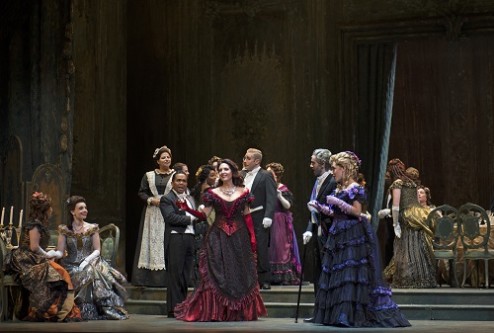 United States Verdi, La traviata: Soloists, Cincinnati Opera Orchestra / Renato Balsadonna (conductor), Cincinnati Opera, Cincinnati Music Hall. Cincinnati, Ohio. 14.6.2018. (RDA)
United States Verdi, La traviata: Soloists, Cincinnati Opera Orchestra / Renato Balsadonna (conductor), Cincinnati Opera, Cincinnati Music Hall. Cincinnati, Ohio. 14.6.2018. (RDA)

Cast:
Violetta Valéry – Norah Amsellem
Alfredo Germont – Ji-Min Park
Giorgio Germont – Youngjoo An
Gastone – Martin Bakari
Baron Douphol – Thomas Dreeze
Marquis D’Obigny – Simon Barrad
Doctor Grenville – James Eder
Flora – Reilly Nelson
Annina – Nicolette Book
Production:
Linda Brovsky (stage director)
Desmond Heeley (production designer)
When Verdi’s La traviata premiered in Venice in 1853, just months after the publication of Alexandre Dumas’ novel, The Lady of the Camelias, Verdi and librettist Francesco Maria Piave had wanted to replicate the novel’s setting in mid-19th century Paris. But the critics gave the composer a few more grey hairs by insisting that the production be played in ‘the time of Richelieu’, to avoid offending the premiere’s Venetian audience with the sexually-charged subject matter.
To add insult to injury, Verdi had chosen the once-very-fine soprano Fanny Salvini-Donatelli to play the role of the courtesan decimated by consumption, but the healthily plump singer was jeered on the opening night audience for her looks and iffy singing. Further, as the elder Germont, Verdi’s baritone of choice Felice Varesi, but that mattered little to the audience, who remained unconvinced by tenor Lodovico Graziani in the role of Violetta’s flame. In the composer’s words, the whole thing was ‘un gran fiasco.’
It was not until years later that the composer’s intentions were honored and vindicated when La traviata received its Paris premiere with Swedish soprano Christine Nilsson, and its second Italian go-around with Maria Spezia Aldighieri. Both ladies were singing birds of a different color: Nilsson, a full-blown Nordic voice ideal for the spinto tirades of the opera’s final act, and, Aldighieri, a bel canto specialist that had cut her teeth on the Rossini-Bellini coloratura repertoire.
And that, in a nutshell is the core challenge of the opera. Wanted: a three-in-one soprano who can spin out ‘È strano!…Ah, fors’è lui’ and then bring the house down with ‘Sempre libera’ in Act I, match the baritone both vocally and dramatically in the extended Act II duet, then re-enter to ride over the ensemble in the finale of the Act II party scene. She then ends the evening by breaking our collective hearts in one of the finest (and longest) death scenes in all of opera.
Norah Amsellem, a stunning French soprano, would have made Verdi very happy. Her film star looks and her dramatic gifts made her utterly convincing as the beautiful courtesan, the high-class toast of tout Paris. And then there’s her voice: a full lyric soprano with a solid top register that encompassed the expected high E flat at the end of Act I, and possessed the heft to cut through the outbursts in the duets with the two Germonts.
Father and son were sung by tenor Ji-Min Park and baritone Youngjoo An, both promising young singers who valiantly held their own opposite Ansellem. Park delivered a fervent ‘Dei miei bollenti spiriti’, and An sang a lovely ‘Di Provenza’—both artists overflowing with conviction in their assignments.
As high society 19th-century Parisians, a cast of up-and-coming Cincinnatians excelled under the firm directorial hand of Linda Brovsky. Among the many recent graduates of the College-Conservatory of Music, the finest among them was baritone Simon Barrad, a fast-rising young artist, who made his Marquis d’Obigny an important dramatic element.
Kudos to the perfect costuming by Canadian production designer Desmond Heeley, who also created the perfect period sets. In the pit, Renato Balsadonna helmed the orchestra with Italianate panache, while giving the cast the necessary elasticity that’s part-and-parcel of the Verdian style.
Rafael de Acha
